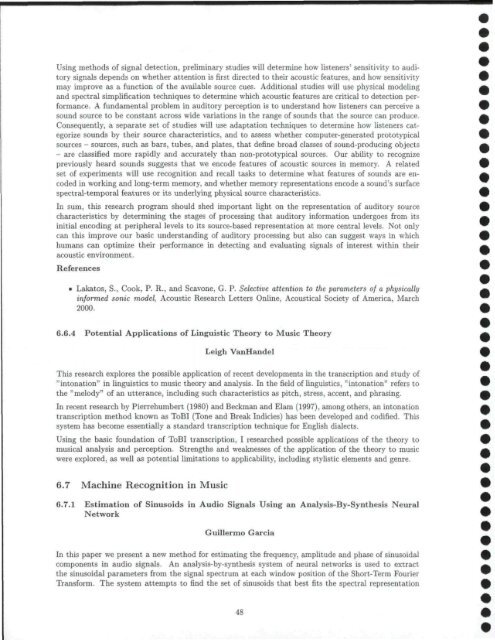CCRMA OVERVIEW - CCRMA - Stanford University
CCRMA OVERVIEW - CCRMA - Stanford University
CCRMA OVERVIEW - CCRMA - Stanford University
Create successful ePaper yourself
Turn your PDF publications into a flip-book with our unique Google optimized e-Paper software.
Using methods of signal detection, preliminary studies will determine how listeners' sensitivity to auditory<br />
signals depends on whether attention is first directed to their acoustic features, and how sensitivity<br />
may improve as a function of the available source cues. Additional studies will use physical modeling<br />
and spectral simplification techniques to determine which acoustic features are critical to detection performance.<br />
A fundamental problem in auditory perception is to understand how listeners can perceive a<br />
sound source to be constant across wide variations in the range of sounds that the source can produce.<br />
Consequently, a separate set of studies will use adaptation techniques to determine how listeners categorize<br />
sounds by their source characteristics, and to assess whether computer-generated prototypical<br />
sources - sources, such as bars, tubes, and plates, that define broad classes of sound-producing objects<br />
- are classified more rapidly and accurately than non-prototypical sources. Our ability to recognize<br />
previously heard sounds suggests that we encode features of acoustic sources in memory. A related<br />
set of experiments will use recognition and recall tasks to determine what features of sounds are encoded<br />
in working and long-term memory, and whether memory representations encode a sound's surface<br />
spectral-temporal features or its underlying physical source characteristics.<br />
In sum, this research program should shed important light on the representation of auditory source<br />
characteristics by determining the stages of processing that auditory information undergoes from its<br />
initial encoding at peripheral levels to its source-based representation at more central levels. Not only<br />
can this improve our basic understanding of auditory processing but also can suggest ways in which<br />
humans can optimize their performance in detecting and evaluating signals of interest within their<br />
acoustic environment.<br />
References<br />
• Lakatos, S., Cook, P. R., and Scavone, G. P. Selective attention to the parameters of a physically<br />
informed sonic model, Acoustic Research Letters Online, Acoustical Society of America, March<br />
2000.<br />
6.6.4 Potential Applications of Linguistic Theory to Music Theory<br />
Leigh VanHandel<br />
This research explores the possible application of recent developments in the transcription and study of<br />
"intonation" in linguistics to music theory and analysis. In the field of linguistics, "intonation" refers to<br />
the "melody" of an utterance, including such characteristics as pitch, stress, accent, and phrasing.<br />
In recent research by Pierrehumbert (1980) and Beckman and Elam (1997), among others, an intonation<br />
transcription method known as ToBI (Tone and Break Indicies) has been developed and codified. This<br />
system has become essentially a standard transcription technique for English dialects.<br />
Using the basic foundation of ToBI transcription, I researched possible applications of the theory to<br />
musical analysis and perception. Strengths and weaknesses of the application of the theory to music<br />
were explored, as well as potential limitations to applicability, including stylistic elements and genre.<br />
6.7 Machine Recognition in Music<br />
6.7.1 Estimation of Sinusoids in Audio Signals Using an Analysis-By-Synthesis Neural<br />
Network<br />
Guillermo Garcia<br />
In this paper we present a new method for estimating the frequency, amplitude and phase of sinusoidal<br />
components in audio signals. An analysis-by-synthesis system of neural networks is used to extract<br />
the sinusoidal parameters from the signal spectrum at each window position of the Short-Term Fourier<br />
Transform. The system attempts to find the set of sinusoids that best fits the spectral representation<br />
45

















